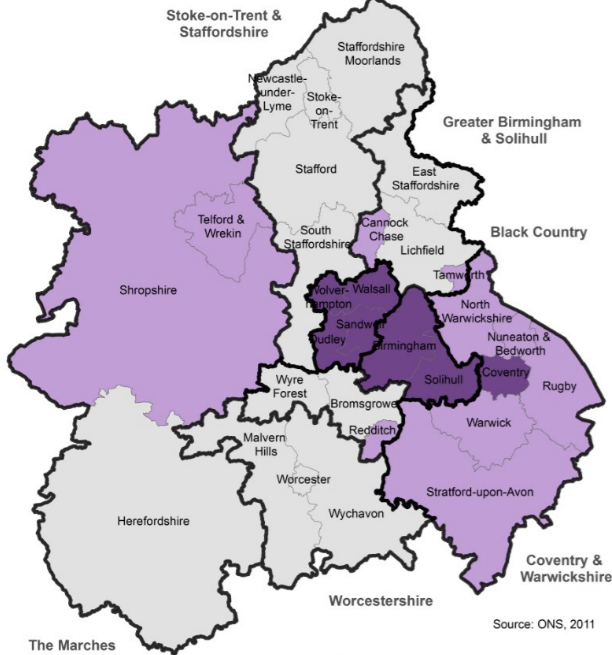 This blog post has been produced to provide insight into the findings of the Birmingham Economic Review.
This blog post has been produced to provide insight into the findings of the Birmingham Economic Review.
The Birmingham Economic Review 2018 is produced by City-REDI, University of Birmingham and the Greater Birmingham Chambers of Commerce, with contributions from the West Midlands Growth Company. It is an in-depth exploration of the economy of England’s second city and is a high-quality resource for organisations seeking to understand Birmingham to inform research, policy or investment decisions.
This post is featured in the full report and report summary here.
There are many ways of considering economic activity. On the one hand, the emphasis may be placed on identifying and exploring generic processes or those that could perhaps be defined as spatially blind processes. On the other hand, there is an appreciation that economic activity is very much influenced and often determined by context. There are many different contexts – from the distinctiveness that comes from enacting business in a particular place or region to the contexts that exist inside a firm. This is to emphasise the importance of understanding firm-level or micro processes and more meso processes that are related to a firm’s place within a city-regional economy.
There are, of course, more macro processes that operate nationally and often internationally. Within this framework of micro, meso and macro scales there are many different forms of action. These include firms that are locally owned and managed to branch offices/plants of translocal firms. Another set of actors are sometimes labelled as non-firm actors and these include the activities of local and national governments.

For the West Midlands, we need to consider three important processes that reflect the three scales at which economic activity is enacted or performed.
First, there is the national/international scale. Here there are major uncertainties that are outside the control of firms located in the West Midlands and outside the control and influence of Birmingham or West Midlands based policy-makers. At this scale, the on-going Brexit negotiations are a major moment of uncertainty for those firms that are involved in supply chains with firms located within the European Union. Brexit, however, must also be placed within the wider context of the ongoing alterations in international trade that have been driven by Donald Trump’s imposition of tariff barriers. It is the onset of what could become a trade war that represents a critical moment of uncertainty for the EU and the UK.
It must be noted that the US is not very dependent on imports or even exports. The US has the largest internal market. The implication is that the new American approach to trade will be more damaging for countries and regions, like the West Midlands, that are important exporters to the US. For the West Midlands, for the year ending 2017, the most important export partners by value were, in order of importance, the USA, China, Germany, France and the Irish Republic (HMRC 2018, Regional Trade in Goods Statistics, Fourth Quarter, HMRC: Southend-on-Sea). For the West Midlands, on-going alterations in the American approach to trade are perhaps one of the most important challenges. Exports from the West Midlands mirror the pattern for the UK. There is a deficit in goods and a surplus in services. This surplus in services is interesting as it is important to appreciate that services have never been a central part of international trade agreements and have been excluded from the current (July 2018) UK government approach to Brexit negotiations.
Second, at a regional level, the West Midlands still lags behind Manchester in terms of GVA per head and this reflects the overall structure of the regional economy which has high concentrations of low value producing sectors, or sectors that are yet to experience major productivity improvements.
 Third, for firms, there are still problems with hard-to-fill vacancies that reflect problems with the local labour market but also the education system. In terms of new firm formation, Birmingham and the West Midlands Combined Authority have an interesting pattern. In comparison to Manchester, Birmingham and the WMCA have lower rates of new firm formation, but also a higher survival rate. This is a good place to be in terms of new firm formation. It is noteworthy that the five-year survival rate for the West Midlands exceeds the national average.
Third, for firms, there are still problems with hard-to-fill vacancies that reflect problems with the local labour market but also the education system. In terms of new firm formation, Birmingham and the West Midlands Combined Authority have an interesting pattern. In comparison to Manchester, Birmingham and the WMCA have lower rates of new firm formation, but also a higher survival rate. This is a good place to be in terms of new firm formation. It is noteworthy that the five-year survival rate for the West Midlands exceeds the national average.
Overall, an annual review of the economic geography of Birmingham does not identify major changes at the firm or regional level. At this scale of analysis, change is gradual or incremental with only occasional major shocks. What is interesting for 2018, is that perhaps one of the greatest shocks that is beginning to be experienced by local firms reflects the outcomes of decisions made in Washington, D.C. rather than in London or Brussels.
It is possible to summarise regional economic success by identifying three key processes that shape economic activity – the degree of connectivity at all scales, the availability of appropriately skilled labour and a high degree of stability or certainty. In terms of connectivity, it is important to appreciate that every firm will be connected to the national and global economy in different ways. Some firms will be more impacted by alterations in local consumption within the West Midlands, others by decisions made by consumers located elsewhere in the UK and in the EU and for many firms decisions made by foreign consumers and governments shape firm performance and competitiveness. This is especially challenging for local policy-makers as they can only focus on influencing one part of the concatenation of processes that influence regional economic activity. The key challenge is to identify local problems that can be addressed by local interventions.
This commentary was written by Professor John Bryson, City-REDI, University of Birmingham.
To sign up to our blog mailing list, please click here.
